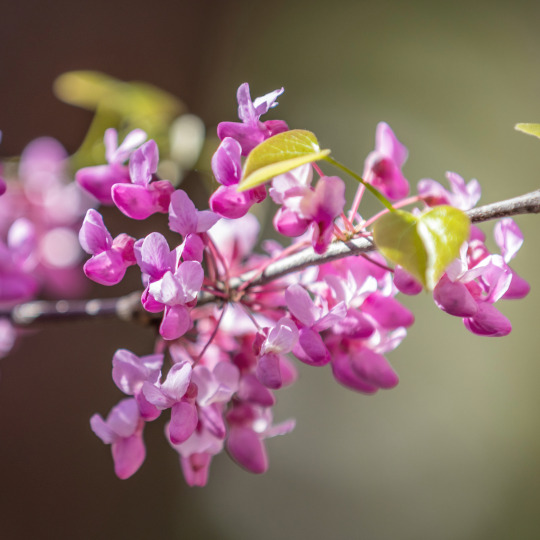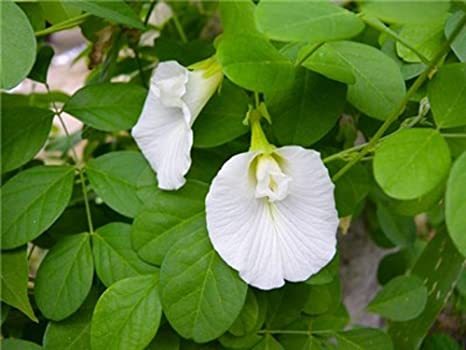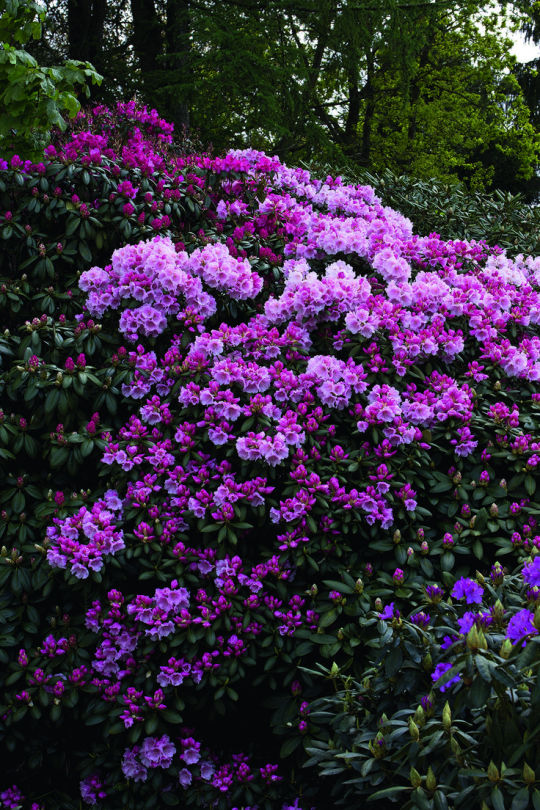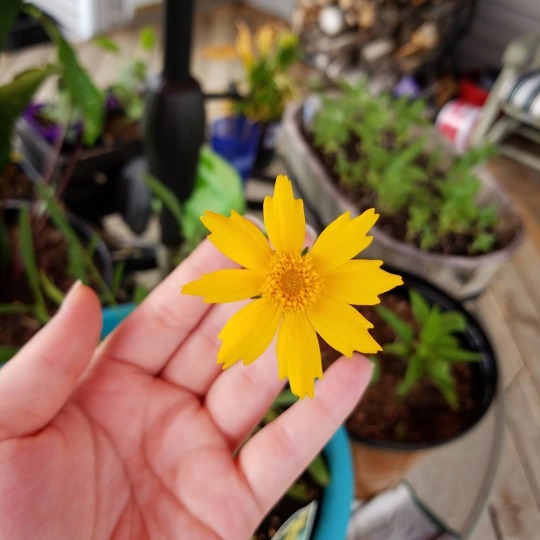#PlantNative
Explore tagged Tumblr posts
Text
"I will destroy you, and I will nourish your replacement with the corpses of your brethren."
Me, addressing the invasive species in my garden, as I mulch the newly planted natives.
6 notes
·
View notes
Text
When Flowers Listen: How Buzzing Bees Unlock a Secret in Nature
Have you ever thought about what flowers hear? It might sound like a strange question, but new research suggests that plants aren’t as passive as we once believed. In fact, they may be far more aware of their world and their pollinators than we ever imagined. A groundbreaking study presented this week by Professor Francesca Barbero and her team at the University of Turin has shown that certain…
#BuzzingWithLife#EcoGardening#GardeningTips#PlantNative#PollinatorAwareness#SaveTheBees#SouthAfricaWildlife#SustainableFarming
0 notes
Text
Embrace Native Trees: The Eastern Redbud (Cercis canadensis)

Adding a splash of color to your landscape has never been easier with the Eastern Redbud (Cercis canadensis). This stunning native tree can transform your garden with its vibrant pink flowers and charming heart-shaped leaves. Let’s dive into why the Eastern Redbud is the perfect addition to your backyard and how it can benefit both you and local wildlife.
Springtime Splendor
Imagine your garden waking up from winter with a burst of color. The Eastern Redbud dazzles in early spring, its branches adorned with small, vibrant pink flowers before the leaves even emerge. These blooms create a breathtaking display that can turn any yard into a picturesque scene, making the Redbud a favorite among gardeners looking to add beauty and charm to their outdoor spaces.
Wildlife Haven
But the Eastern Redbud isn’t just about looks. It’s also a fantastic choice for creating a wildlife-friendly garden. Here’s why:
Pollinator Paradise: The vibrant flowers attract a variety of pollinators, including bees and butterflies. By planting a Redbud, you’re helping support these crucial creatures, which play a vital role in our ecosystems.
Bird Buffet: Once the flowers fade, the Redbud produces seed pods that are a valuable food source for birds. Sparrows, finches, and other species will thank you for this delicious addition to their diet.
Planting and Caring for Your Eastern Redbud
Ready to bring this beautiful tree into your garden? Here are some tips to ensure your Eastern Redbud thrives:
Choose the Right Spot: Eastern Redbuds prefer well-drained soil and can tolerate both full sun and partial shade. Make sure you plant your tree where it has enough space to grow to its full size, which can be up to 30 feet tall and wide.
Watering: Young Redbuds need regular watering, especially during dry spells. Once established, they are relatively drought-tolerant, but a little extra water during hot, dry periods can help them stay healthy.
Mulching: Apply a layer of mulch around the base of your tree to retain moisture, regulate soil temperature, and suppress weeds.
Pruning: Prune your Redbud in late winter or early spring to remove any dead or diseased branches and to shape the tree. This helps maintain its health and beauty.
Why Choose Native?
Planting native trees like the Eastern Redbud has numerous benefits. They are well-adapted to local conditions, require less maintenance, and support local wildlife. By choosing natives, you’re not only enhancing your garden’s beauty but also contributing to a healthier environment.
Conclusion
The Eastern Redbud is more than just a tree; it’s a symbol of the beauty and resilience of nature. By planting one in your garden, you’re making a statement about the importance of preserving our natural heritage and supporting local ecosystems. So why wait? Add a splash of color and a touch of nature’s magic to your landscape with an Eastern Redbud.
For more tips on sustainable living and gardening, be sure to explore our other blog posts. Happy planting!
#EasternRedbud#NativeTrees#SpringtimeSplendor#WildlifeGarden#PollinatorFriendly#SustainableGardening#GardenInspiration#PlantNative#EcoFriendlyGardening#TreePlanting#BackyardBliss#GardenTips#NatureLovers#GreenLiving#BeautifyYourYard#greenguidetips
0 notes
Text
cliatoria-ternatea-white

Buy the Clitoria ternatea -White multi petaled plant from Santhi online plant nursery website. This Aparajita plant grows as an evergreen herbaceous plant. The butterfly pea white flowers are multi-petaled and grow creeper. This flowering creepers has elliptic ovate leaves. Mature plants reach up to the height of 4 cm wide as vine plants.
FERTILIZER: Application of goat manure monthly once around the Aparajita flower plants.
PROPAGATION: Done through seeds.
TRANSPLANTATION: Transplant the seeds when the seedling reaches a height of about 6-7 inches
PRUNING: Trim the old matured plant flowers, seed pods & other butterfly pea plant parts.
BENEFITS:
These Aparajita flower plants are considered to be holy pooja flowers.
The butterfly pea plants fast growing & low maintenance flowering creepers.
White flowers in multi-petaled give good flower yield.
Clitoria ternatea -White petaled plants are the most popular nowadays and in high demand nowadays, we offer these plants at affordable cost and you can buy the best online plants from us.
#cliatoria-ternatea-white#planting#forming#garden#garden plants#green plants#flower#white flower#plantning#leaves#plant care#plants#https://www.santhionlineplants.com/product/clitoria-ternatea-white-multi-petaled/
1 note
·
View note
Text

Ian update: got him some soil so he can (hopefully) grow big and strong🍅

This is the most Ian Gallagher thing to ever happen to me
#i am aware that I’m about two months late to be plantning tomatoes sjdksjs#especially in my part of the world#but I am determined to see this lil thing grow#also Idk if you guys are invested in this but i sure am so you have to deal with it aswell#tomato Ian#shameless
48 notes
·
View notes
Text

Dyrk den farverige rhododendron i din have. Lær om dens pasning, plantning, og hvordan du får den til at blomstre fra ma...
6 notes
·
View notes
Text
Ja ja her, en halv snese dag efter plantning, har de første blomst besluttet at være med. Vidunderligt.
Vi har også tilsluttet og opstartet grillen, det var så perfekt, hmmm.



Er vilde med vores "Aftægten" ♥️
3 notes
·
View notes
Text
Hi I work at a native plant nursery in the Pacific Northwest!
The Portland Plant List is the rubric used by the Backyard Habitat Program to certify residential planting projects in the Portland area, including Southwest Washington. If you're within the Backyard Habitat service area, their team will come to your property and perform a site assessment, then provide a comprehensive list of plants that will work on your property, along with coupons to local native nurseries and lots of great resources. Plus you get a snazzy sign!
Some blogs/websites with directories of native plant nurseries (cannot vouch for how complete these are, please check with the business first):
Grow It Build It
The Plant Native
PlantNative
Other resources:
Real Gardens Grow Natives, a PNW-focused book and website
Native Plants PNW, an incredible resource I use CONSTANTLY. Covers plant distribution, habitat, growth conditions, ID advice, propagation tips and even ethnobotanical uses.
Washington Native Plant Society, with regional chapters and lots of info for conservation, volunteering, gardening and more.
Also, lots of language around planting natives is aimed at homeowners and/or those able-bodied enough to take care of huge swathes of land. Renters can and should get in on native planting!! Small yards are essential ecosystem participants!! A patio garden in a noisy urban zone is still a garden!!! Look at the High Line conversion in Manhattan - it's in the middle of goddamn MANHATTAN and it's not even fully planted with natives but monarch butterflies and native bees still find it and use it! Even if all you can contribute is a trio of keystone species in a container, that's one more piece of habitat that wasn't there before and so many bugs and birds will thank you!
Planet's Fucked: What Can You Do To Help? (Long Post)
Since nobody is talking about the existential threat to the climate and the environment a second Trump term/Republican government control will cause, which to me supersedes literally every other issue, I wanted to just say my two cents, and some things you can do to help. I am a conservation biologist, whose field was hit substantially by the first Trump presidency. I study wild bees, birds, and plants.
In case anyone forgot what he did last time, he gagged scientists' ability to talk about climate change, he tried zeroing budgets for agencies like the NOAA, he attempted to gut protections in the Endangered Species Act (mainly by redefining 'take' in a way that would allow corporations to destroy habitat of imperiled species with no ramifications), he tried to do the same for the Migratory Bird Treaty Act (the law that offers official protection for native non-game birds), he sought to expand oil and coal extraction from federal protected lands, he shrunk the size of multiple national preserves, HE PULLED US OUT OF THE PARIS CLIMATE AGREEMENT, and more.
We are at a crucial tipping point in being able to slow the pace of climate change, where we decide what emissions scenario we will operate at, with existential consequences for both the environment and people. We are also in the middle of the Sixth Mass Extinction, with the rate of species extinctions far surpassing background rates due completely to human actions. What we do now will determine the fate of the environment for hundreds or thousands of years - from our ability to grow key food crops (goodbye corn belt! I hated you anyway but), to the pressure on coastal communities that will face the brunt of sea level rise and intensifying extreme weather events, to desertification, ocean acidification, wildfires, melting permafrost (yay, outbreaks of deadly frozen viruses!), and a breaking down of ecosystems and ecosystem services due to continued habitat loss and species declines, especially insect declines. The fact that the environment is clearly a low priority issue despite the very real existential threat to so many people, is beyond my ability to understand. I do partly blame the public education system for offering no mandatory environmental science curriculum or any at all in most places. What it means is that it will take the support of everyone who does care to make any amount of difference in this steeply uphill battle.
There are not enough environmental scientists to solve these issues, not if public support is not on our side and the majority of the general public is either uninformed or actively hostile towards climate science (or any conservation science).
So what can you, my fellow Americans, do to help mitigate and minimize the inevitable damage that lay ahead?
I'm not going to tell you to recycle more or take shorter showers. I'll be honest, that stuff is a drop in the bucket. What does matter on the individual level is restoring and protecting habitat, reducing threats to at-risk species, reducing pesticide use, improving agricultural practices, and pushing for policy changes. Restoring CONNECTIVITY to our landscape - corridors of contiguous habitat - will make all the difference for wildlife to be able to survive a changing climate and continued human population expansion.
**Caveat that I work in the northeast with pollinators and birds so I cannot provide specific organizations for some topics, including climate change focused NGOs. Scientists on tumblr who specialize in other fields, please add your own recommended resources. **
We need two things: FUNDING and MANPOWER.
You may surprised to find that an insane amount of conservation work is carried out by volunteers. We don't ever have the funds to pay most of the people who want to help. If you really really care, consider going into a conservation-related field as a career. It's rewarding, passionate work.
At the national level, please support:
The Nature Conservancy
Xerces Society for Invertebrate Conservation
Cornell Lab of Ornithology (including eBird)
National Audubon Society
Federal Duck Stamps (you don't need to be a hunter to buy one!)
These first four work to acquire and restore critical habitat, change environmental policy, and educate the public. There is almost certainly a Nature Conservancy-owned property within driving distance of you. Xerces plays a very large role in pollinator conservation, including sustainable agriculture, native bee monitoring programs, and the Bee City/Bee Campus USA programs. The Lab of O is one of the world's leaders in bird research and conservation. Audubon focuses on bird conservation. You can get annual memberships to these organizations and receive cool swag and/or a subscription to their publications which are well worth it. You can also volunteer your time; we need thousands of volunteers to do everything from conducting wildlife surveys, invasive species removal, providing outreach programming, managing habitat/clearing trails, planting trees, you name it. Federal Duck Stamps are the major revenue for wetland conservation; hunters need to buy them to hunt waterfowl but anyone can get them to collect!
THERE ARE DEFINITELY MORE, but these are a start.
Additionally, any federal or local organizations that seek to provide support and relief to those affected by hurricanes, sea level rise, any form of coastal climate change...
At the regional level:
These are a list of topics that affect major regions of the United States. Since I do not work in most of these areas I don't feel confident recommending specific organizations, but please seek resources relating to these as they are likely major conservation issues near you.
PRAIRIE CONSERVATION & PRAIRIE POTHOLE WETLANDS
DRYING OF THE COLORADO RIVER (good overview video linked)
PROTECTION OF ESTUARIES AND SALTMARSH, ESPECIALLY IN THE DELAWARE BAY AND LONG ISLAND (and mangroves further south, everglades etc; this includes restoring LIVING SHORELINES instead of concrete storm walls; also check out the likely-soon extinction of saltmarsh sparrows)
UNDAMMING MAJOR RIVERS (not just the Colorado; restoring salmon runs, restoring historic floodplains)
NATIVE POLLINATOR DECLINES (NOT honeybees. for fuck's sake. honeybees are non-native domesticated animals. don't you DARE get honeybee hives to 'save the bees')
WILDLIFE ALONG THE SOUTHERN BORDER (support the Mission Butterfly Center!)
INVASIVE PLANT AND ANIMAL SPECIES (this is everywhere but the specifics will differ regionally, dear lord please help Hawaii)
LOSS OF WETLANDS NATIONWIDE (some states have lost over 90% of their wetlands, I'm looking at you California, Ohio, Illinois)
INDUSTRIAL AGRICULTURE, esp in the CORN BELT and CALIFORNIA - this is an issue much bigger than each of us, but we can work incrementally to promote sustainable practices and create habitat in farmland-dominated areas. Support small, local farms, especially those that use soil regenerative practices, no-till agriculture, no pesticides/Integrated Pest Management/no neonicotinoids/at least non-persistent pesticides. We need more farmers enrolling in NRCS programs to put farmland in temporary or permanent wetland easements, or to rent the land for a 30-year solar farm cycle. We've lost over 99% of our prairies to corn and soybeans. Let's not make it 100%.
INDIGENOUS LAND-BACK EFFORTS/INDIGENOUS LAND MANAGEMENT/TEK (adding this because there have been increasing efforts not just for reparations but to also allow indigenous communities to steward and manage lands either fully independently or alongside western science, and it would have great benefits for both people and the land; I know others on here could speak much more on this. Please platform indigenous voices)
HARMFUL ALGAL BLOOMS (get your neighbors to stop dumping fertilizers on their lawn next to lakes, reduce agricultural runoff)
OCEAN PLASTIC (it's not straws, it's mostly commercial fishing line/trawling equipment and microplastics)
A lot of these are interconnected. And of course not a complete list.
At the state and local level:
You probably have the most power to make change at the local level!
Support or volunteer at your local nature centers, local/state land conservancy non-profits (find out who owns&manages the preserves you like to hike at!), state fish & game dept/non-game program, local Audubon chapters (they do a LOT). Participate in a Christmas Bird Count!
Join local garden clubs, which install and maintain town plantings - encourage them to use NATIVE plants. Join a community garden!
Get your college campus or city/town certified in the Bee Campus USA/Bee City USA programs from the Xerces Society
Check out your state's official plant nursery, forest society, natural heritage program, anything that you could become a member of, get plants from, or volunteer at.
Volunteer to be part of your town's conservation commission, which makes decisions about land management and funding
Attend classes or volunteer with your land grant university's cooperative extension (including master gardener programs)
Literally any volunteer effort aimed at improving the local environment, whether that's picking up litter, pulling invasive plants, installing a local garden, planting trees in a city park, ANYTHING. make a positive change in your own sphere. learn the local issues affecting your nearby ecosystems. I guarantee some lake or river nearby is polluted
MAKE HABITAT IN YOUR COMMUNITY. Biggest thing you can do. Use plants native to your area in your yard or garden. Ditch your lawn. Don't use pesticides (including mosquito spraying, tick spraying, Roundup, etc). Don't use fertilizers that will run off into drinking water. Leave the leaves in your yard. Get your school/college to plant native gardens. Plant native trees (most trees planted in yards are not native). Remove invasive plants in your yard.
On this last point, HERE ARE EASY ONLINE RESOURCES TO FIND NATIVE PLANTS and LEARN ABOUT NATIVE GARDENING:
Xerces Society Pollinator Conservation Resource Center
Pollinator Pathway
Audubon Native Plant Finder
Homegrown National Park (and Doug Tallamy's other books)
National Wildlife Federation Native Plant Finder (clunky but somewhat helpful)
Heather Holm (for prairie/midwest/northeast)
MonarchGard w/ Benjamin Vogt (for prairie/midwest)
Native Plant Trust (northeast & mid-atlantic)
Grow Native Massachusetts (northeast)
Habitat Gardening in Central New York (northeast)
There are many more - I'm not familiar with resources for western states. Print books are your biggest friend. Happy to provide a list of those.
Lastly, you can help scientists monitor species using citizen science. Contribute to iNaturalist, eBird, Bumblebee Watch, or any number of more geographically or taxonomically targeted programs (for instance, our state has a butterfly census carried out by citizen volunteers).
In short? Get curious, get educated, get involved. Notice your local nature, find out how it's threatened, and find out who's working to protect it that you can help with. The health of the planet, including our resilience to climate change, is determined by small local efforts to maintain and restore habitat. That is how we survive this. When government funding won't come, when we're beat back at every turn trying to get policy changed, it comes down to each individual person creating a safe refuge for nature.
Thanks for reading this far. Please feel free to add your own credible resources and organizations.
19K notes
·
View notes
Text
0 notes
Text
0 notes
Photo

When your clients are so happy with their pollinator habitat, they send you its progress pictures. First picture is the closing on the home in 2018 to now. The others are the 138 day progression from install this spring. Thank you @jordanghawi and @stephmariephil for your trust in The Nectar Bar to complete your vision and providing habitat for our pollinators! ✌🏼💜🦋🦋 #HappyClients #TheNectarBar #PlantNative #NativeHostPlants #HostPlantsForButterflies #PeaceLoveAndButterflies #Butterflies #NativePlants #Nature #TheNecatarBar #HealthyEcosystem #NativesForWildlife #NativesAreImportant #PocketPrairie #NativePocketPrairie #NativeGrasslands #EcoregionsMatter #NativePlantHike #LearningNatives #LearningNativePlants #WaterSaver #WatershedWiseSA https://www.instagram.com/p/CSPHNRFMPhl/?utm_medium=tumblr
#happyclients#thenectarbar#plantnative#nativehostplants#hostplantsforbutterflies#peaceloveandbutterflies#butterflies#nativeplants#nature#thenecatarbar#healthyecosystem#nativesforwildlife#nativesareimportant#pocketprairie#nativepocketprairie#nativegrasslands#ecoregionsmatter#nativeplanthike#learningnatives#learningnativeplants#watersaver#watershedwisesa
1 note
·
View note
Text
ii love plantn they a re so yummies :)
scared as usaual but happ y today. delihgted by the flora thaat exists within myforest...... leaves annd tree s and moss and fungi.... plants are so inchrresting <:)
10 notes
·
View notes
Photo

Recognize this plant? If you have it in your yard, you may want to remove it. It's the next on our list of Dirty Dozen invasives. Link in bio under stories. 📷Nicole Plummer . . . . . . #ItalianArum #Invasives #InvasivePlants #Arumitalicum #Arum #DontPlantThis #GoNative #PlantNative #Native #NativePlants #plantlove #Plants #Gardens #Gardening #gardeningtips (at Lewis Ginter Botanical Garden) https://www.instagram.com/p/CM5IuppFyJv/?igshid=6zo5dgn2b42x
#italianarum#invasives#invasiveplants#arumitalicum#arum#dontplantthis#gonative#plantnative#native#nativeplants#plantlove#plants#gardens#gardening#gardeningtips
4 notes
·
View notes
Text
Cluster Beans Plant(Kothavarangai)

Cluster bean plants are houseplants and long-duration plants. It belongs to the nightshade family and is categorized under outdoor, garden, and vegetable.
COMMON NAME: Cluster beans
SCIENTIFIC NAME: Cyamopsis tetragonoloba L
FAMILY: Fabaceae
SOIL: Love to grow well-drained sandy loam soil
SUNLIGHT: Require bright indirect sunlight
PLANT HEIGHT: 2 to 4 feet.
0 notes
Photo

You are my sunshine~ ☀️🌻 #lanceleafcoreopsis #coreopsis #plantnative #feedthebees https://www.instagram.com/p/CBMqK3RAUzE/?igshid=19i8qp03mmlmt
1 note
·
View note